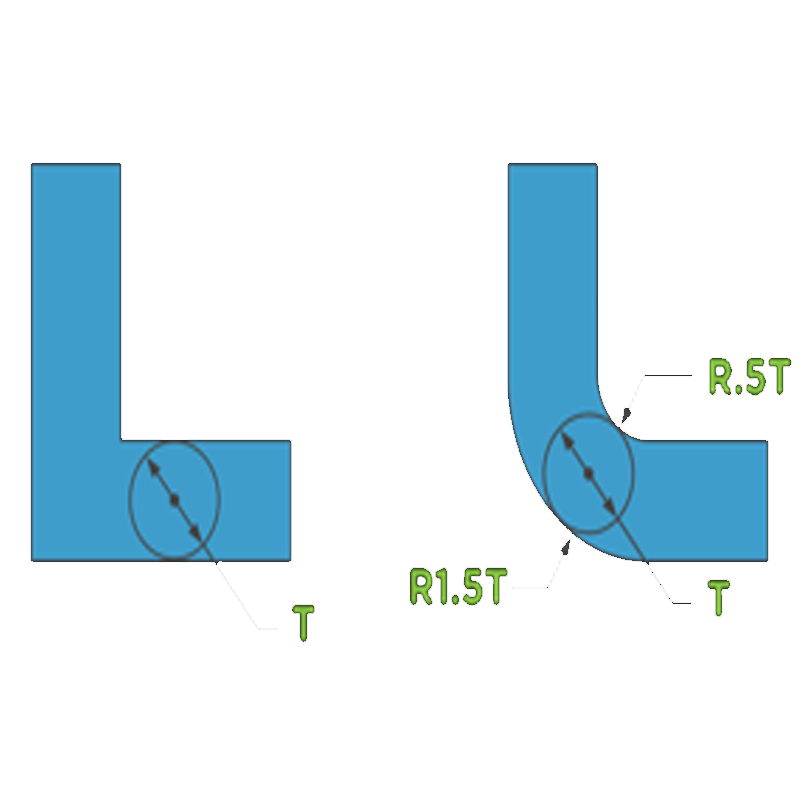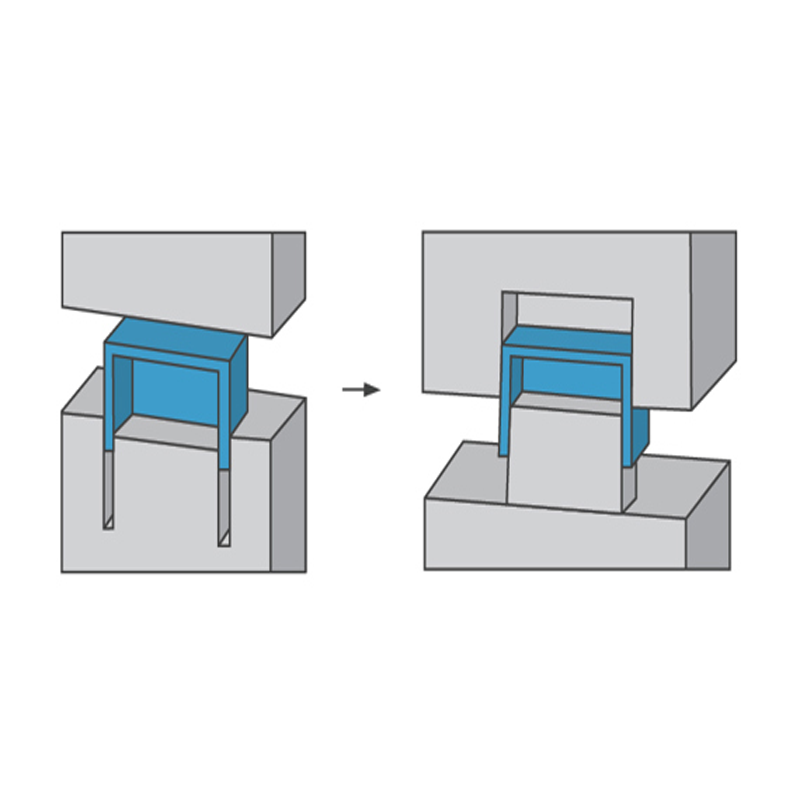Injection molding is a versatile and widely used manufacturing process, but successful execution hinges on several crucial design elements. At YJCPolymer, we understand that parts can enter the injection molding process through various routes—some are first prototyped using 3D printing, others undergo traditional machining, and some jump directly into injection molding. Regardless of the route, certain key design considerations need to be addressed early on to enhance moldability, prevent production issues, and ensure high-quality, functional parts. These considerations help mitigate production hiccups, cosmetic defects, and other challenges.
1. Draft and Radii: Ensuring Easy Mold Release and Optimal Plastic Flow
One of the fundamental aspects of a well-designed injection-molded part is the inclusion of draft and radii. Draft angles, which allow a part to easily release from the mold, are essential to reduce surface friction. Without proper draft, parts may stick to the mold, requiring excessive pressure to eject, which could result in part damage or even mold damage. Typically, applying 1 degree of draft per 25mm of cavity depth is a good starting point, though the specific material and tooling capabilities may require adjustments.

At YJCPolymer, we leverage advanced CNC milling techniques to produce our molds, which allows us to optimize both draft angles and wall thicknesses based on the specific tools used. Our Design for Manufacturability (DFM) analysis software evaluates each part feature individually, providing real-time insights and suggesting design adjustments to optimize moldability.
In addition to draft, radii are equally important. While radii aren’t strictly required, their inclusion significantly enhances plastic flow and part integrity. Just as water in a river moves more efficiently around curved surfaces, plastic resin flows more smoothly around rounded corners. This reduces stress on the material, minimizes the risk of defects, and aids in part ejection, preventing warping or breakage.

2. Wall Thickness: Striking a Balance Between Strength, Weight, and Cosmetic Appeal
Proper wall thickness is another critical factor in part design, as it directly influences a part’s cosmetic appearance, structural strength, and weight. Excessive thickness can lead to issues such as sink marks, warp, and internal voids (air pockets). To prevent these problems, following recommended wall thickness guidelines is essential, though these guidelines are only a starting point. At YJCPolymer, we recognize that each part is unique, and we tailor our designs accordingly to meet the specific requirements of the material, functionality, and application.
In addition to managing wall thickness, incorporating ribs and gussets can significantly improve part strength without increasing wall thickness. This approach helps maintain the part’s integrity while reducing issues like warp and sink. We also advise that the rib-to-wall thickness ratio should be maintained at around 50%, as excessively thick ribs can cool at different rates than the surrounding material, leading to undesirable stresses and distortions in the part.

3. Coring and Ribbing: Enhancing Structural Integrity and Reducing Defects
At YJCPolymer, we often recommend coring out thicker sections of a part, which allows us to reduce material usage and weight without sacrificing performance. By keeping the outer dimensions of the part intact, we can maintain strength while improving both the cosmetic appearance and performance.
Incorporating ribs into the design is also vital for adding strength to the part. However, it’s essential to adhere to an ideal rib-to-wall thickness ratio, typically around 40-60% of the wall thickness. This balance prevents over-thick sections that could cause uneven cooling, potentially resulting in sink marks or warping.
In addition, gussets—triangular support structures—are commonly used to support walls and features while reducing molding stresses. Properly designed ramps and smooth transitions between features also improve material flow and reduce the risk of defects.

4. Core-Cavity Design: Improving Efficiency and Reducing Manufacturing Costs
The core-cavity design approach is a critical technique for simplifying the injection molding process and enhancing both moldability and part quality. Often referred to as the “A” and “B” sides of the mold, the core and cavity must be designed to work in harmony to reduce manufacturing time and costs. For example, when designing a part like a box, applying draft to both the inside and outside surfaces within the same mold half creates a deep rib, which increases tooling costs and complicates ejection.
The core-cavity approach avoids this problem by ensuring that the internal and external surfaces are parallel and properly drafted, maintaining a consistent wall thickness and part integrity. This approach not only improves the part’s moldability but also minimizes costs and improves the overall part quality.
5. Handling Undercuts: Complex Designs Made Easy
While it’s commonly assumed that rapid injection molding requires simple part designs, we at YJCPolymer specialize in accommodating complex parts that require features such as undercuts, through-holes, and other intricate geometries. External undercuts are relatively easy to manage with side-actions, which move in tandem with the mold, allowing for the creation of undercuts without compromising part ejection.
In cases where side-actions aren’t feasible, manual inserts can be used. These inserts are loaded into the mold before closing, and after molding, the operator removes them manually. This technique allows us to produce parts with greater design flexibility without significantly increasing costs.

6. Gating and Ejection: Optimizing Material Flow and Part Ejection
Gating and ejection systems play an integral role in the injection molding process. They ensure that plastic resin enters the mold in the most efficient manner and that molded parts are ejected effectively. YJCPolymer uses a range of gating methods, including tab gates, sub gates, and hot tip gates, to achieve optimal flow and minimize waste.
- Tab gatesare commonly used for their processing flexibility and ability to handle increased sizes, while sub gates and tunnel gates reduce visible gate vestiges, making them ideal for cosmetic parts.
- Hot tip gatesare particularly advantageous for balanced filling and minimal waste, resulting in aesthetically pleasing and functional parts.
- Direct sprue gates, though less visually appealing, are suited for specific materials or parts that require secondary machining.
7. Advanced Tools and DFM Analysis: Streamlining the Process
At YJCPolymer, we make use of 3D CAD models and an interactive quote system to provide quick and accurate pricing and production timelines. Along with this, we offer DFM analysis to pinpoint potential molding issues before production even begins. This analysis helps identify areas where adjustments may be needed to enhance moldability and ensure that the final part meets all functional and aesthetic requirements.
If you have a design in mind, we invite you to upload your 3D CAD model to our platform, where you’ll receive an immediate interactive quote and DFM feedback. Our team of experienced applications engineers will also be available to offer personalized advice and further refine the design for optimal manufacturing success.

At YJCPolymer, we are committed to delivering high-quality, cost-effective solutions for all your injection molding needs. Whether you’re moving into low-volume or high-volume production, we provide comprehensive support throughout the design and manufacturing process, ensuring that your parts meet the highest standards of performance and aesthetics.
We encourage you to get in touch with us today! Upload your design and let YJCPolymer help you streamline your product development process. Our team is ready to assist with any questions or guidance you might need, and we’re eager to help bring your vision to life with precision and efficiency.